Difference and Variance in Nutrient Intake by Age for Older Adults Living Alone in Japan: Comparison of Dietary Reference Intakes for the Japanese Population
Abstract
1. Introduction
2. Materials and Methods
2.1. Study Population and Procedure
2.2. Nutrient Intake by 2-Day Weighed Dietary Records
2.3. Usual Nutrient Intake Estimated Using the Agevar Mode
2.4. Body Measurements
2.5. Frailty and Other Variables
2.6. Statistics
- Amounts of daily nutrient intake were surveyed for 2 days to be approximately normally distributed using the Box–Cox transformation [19].
- The mean of the transformed data was modeled to be explained by the polynomial and logarithmic functions of age and within- and between-individual variances of data using a monotone exponential function of age. In this step, the transformed scale of the nutrient was assumed. Moreover, within- and between-individual variances of daily nutritional intakes should be normally distributed around the estimated mean of each individual and at each age group, respectively.
- Within-individual variance was then omitted from the estimated nutrient distribution for each age group given that the estimated mean and between-individual variance would establish the distribution of usual nutritional intake in the transformed scale.
- For the estimated distribution of usual nutritional intake in the transformed scale, percentiles of the data were estimated using the mean and between-individual variance for each age group.
- The distribution of the usual nutrient intake in the original scale of the nutrients was obtained by a reverse transformation of the usual intake distribution in the Box–Cox transformed scale. In this step, the estimated percentiles were reversed.
- Previous studies reported that bias would be mathematically induced in reverse transformation [14]. Therefore, the bias was reduced as per the equation, and the final distribution of usual intake in the original scale was obtained. In other words, within- and between-individual variations reported in the study are those observed before eliminating within-person variance to estimate usual intake.
- The estimated distribution was then graphically presented as percentile curves representing usual nutrient and daily intakes in the original and transformed scales, respectively, and curves representing within- and between-individual variances and the ratio of within-/between-individual variance in the transformed scale. The shaded areas of the 2.5%, 50%, and 97.5% percentile curves indicate the standard errors of the estimated intake distribution to demonstrate the magnitude of the estimation error owing to the sample size.
- Furthermore, the usual intake of nutrients was assessed by comparing the current observations with the 2020 DRIs_J. The survey was conducted between 2012 and 2013. However, the DRIs_J version was used for analysis because it was developed on the basis of new evidences and was a standard that is comprehensively divided into periods for older adults. For the 2020 DRIs_J, the reference intake is set for the age groups of 65–74 and ≥75 years [20]. The DRIs_J for the EAR for protein (g/day) indicated that men and women aged 65–74 years and 75 years and above require ≥50 and ≥40 g/day of protein, respectively. For DGs (tentative dietary goals for preventing lifestyle related diseases) of salt equivalent (g/day), the DRIs_J imply that men and women aged 65–74 years and 75 years and above need to consume <7.5 and <6.5 g/day, respectively. For the DG of potassium (mg/day), the DRIs_J suggest that men and women aged 65–74 years and 75 years and above should consume ≥3000 and ≥2600 mg/day, respectively. In terms of the EAR of calcium (mg/day), ≥600 and ≥550 mg/day are appropriate for men and women aged 65–74 years and 75 years and above, respectively.
- The graph displays changes with age of the estimated percentage of individuals under the EAR or those who exceeded the DG in DRIs_J.
- Statistical analyses were performed using SAS software version 9.4 (SAS Institute, Inc., Cary, NC, USA). A p-value of <0.05 was considered statistically significant.
3. Results
3.1. Usual Nutrient Intake
3.2. Within- and between-Individual Variances of Nutrients
3.3. Proportion of Individuals with a Usual Intake Less or More Than the Estimated Average Requirement (EAR) or Tentative Dietary Goals for Preventing Lifestyle-Related Diseases
4. Discussion
Supplementary Materials
Author Contributions
Funding
Institutional Review Board Statement
Informed Consent Statement
Data Availability Statement
Acknowledgments
Conflicts of Interest
References
- World Health Organization. Integrated Care for Older People: Guidelines on Community-Level Interventions to Manage Declines in Intrinsic Capacity. Available online: https://apps.who.int/iris/handle/10665/258981 (accessed on 1 March 2021).
- Stipp, D. Linking nutrition, maturation and aging: From thrifty genes to the spendthrift phenotype. Aging 2011, 3, 85–93. [Google Scholar] [CrossRef]
- Fukumoto, A.; Asakura, K.; Murakami, K.; Sasaki, S.; Okubo, H.; Hirota, N.; Notsu, A.; Todoriki, H.; Miura, A.; Fukui, M.; et al. Within-and between-individual variation in energy and nutrient intake in Japanese adults: Effect of age and sex differences on group size and number of records required for adequate dietary assessment. J. Epidemiol. 2013, 23, 178–186. [Google Scholar] [CrossRef]
- Tooze, J.A.; Midthune, D.; Dodd, K.W.; Freedman, L.S.; Krebs-Smith, S.M.; Subar, A.F.; Guenther, P.M.; Carroll, R.J.; Kipnis, V. A new statistical method for estimating the usual intake of episodically consumed foods with application to their distribution. J. Am. Diet. Assoc. 2006, 106, 1575–1587. [Google Scholar] [CrossRef]
- Laureano, G.H.C.; Torman, V.B.L.; Crispim, S.P.; Dekkers, A.L.M.; Camey, S.A. Comparison of the ISU, NCI, MSM, and SPADE Methods for Estimating Usual Intake: A Simulation Study of Nutrients Consumed Daily. Nutrients 2016, 15, 166. [Google Scholar] [CrossRef]
- Yokomichi, H.; Yokoyama, T.; Takahashi, K. An improved statistical method to estimate usual intake distribution of nutrients by age group. J. Nutr. Food Sci. 2013, 3, 2. [Google Scholar] [CrossRef]
- Shimazu, T.; Kuriyama, S.; Hozawa, A.; Ohmori, K.; Sato, Y.; Nakaya, N.; Nishino, Y.; Tsubono, Y.; Tsuji, I. Dietary patterns and cardiovascular disease mortality in Japan: A prospective cohort study. Int. J. Epidemiol. 2007, 36, 600–609. [Google Scholar] [CrossRef]
- Nozue, M.; Ishikawa, M.; Takemi, Y.; Kusama, K.; Fukuda, Y.; Yokoyama, T.; Nakaya, T.; Nishi, N.; Yoshiba, K.; Murayama, N. Prevalence of inadequate nutrient intake in Japanese community-dwelling older adults who live alone. J. Nutr. Sci. Vitaminol. 2016, 62, 116–122. [Google Scholar] [CrossRef]
- Ishikawa, M.; Yokoyama, T.; Hayashi, F.; Takemi, Y.; Nakaya, T.; Fukuda, Y.; Kusama, K.; Nozue, M.; Yoshiike, N.; Murayama, N. Subjective well-being is associated with food behavior and demographic factors in chronically ill older Japanese people living alone. J. Nutr. Health Aging 2018, 22, 341–353. [Google Scholar] [CrossRef]
- Ishikawa, M.; Yokoyama, T.; Nakaya, T.; Fukuda, Y.; Takemi, Y.; Kusama, K.; Yoshiike, N.; Nozue, M.; Yoshiba, K.; Murayama, N. Food accessibility and perceptions of shopping difficulty among elderly people living alone in Japan. J. Nutr. Health Aging 2016, 20, 904–911. [Google Scholar] [CrossRef] [PubMed]
- Ishikawa, M.; Takemi, Y.; Yokoyama, T.; Kusama, K.; Fukuda, Y.; Nakaya, T.; Nozue, M.; Yoshiike, N.; Yoshiba, K.; Hayashi, F.; et al. “Eating together” is associated with food behaviors and demographic factors of older Japanese people who live alone. J. Nutr. Health Aging 2017, 21, 662–672. [Google Scholar] [CrossRef] [PubMed]
- National Health and Nutrition Survey. Available online: https://www.nibiohn.go.jp/eiken/kenkounippon21/en/eiyouchousa/ (accessed on 8 December 2020).
- Ministry of Education, Culture, Sports, Science and Technology, Japan. Standard Tables of Food Composition in Japan. 2015. Available online: https://www.mhlw.go.jp/stf/seisakunitsuite/bunya/kenkou_iryou/kenkou/eiyou/syokuji_kijyun.html (accessed on 15 March 2021).
- Dodd, K.W.; Guenther, P.M.; Freedman, L.S.; Subar, A.F.; Kipnis, V.; Midthune, D.; Tooze, J.A.; Krebs-Smith, S.M. Statistical methods for estimating usual intake of nutrients and foods: A review of the theory. J. Am. Diet. Assoc. 2006, 106, 1640–1650. [Google Scholar] [CrossRef] [PubMed]
- Subcommittee on Interpretation and Uses of Dietary Reference Intakes; Institute of Medicine (US) Standing Committee on the Scientific Evaluation of Dietary Reference Intakes. Using Dietary Reference Intakes in Planning Diets for Groups. Dietary Reference Intakes: Applications in Dietary Planning; Institute of Medicine; National Academies Press: Washington, DC, USA, 2003. Available online: https://www.ncbi.nlm.nih.gov/books/NBK221364/ (accessed on 15 March 2021).
- Guenther, P.M.; Kott, P.S.; Carriquiry, A.L. Development of an approach for estimating usual nutrient intake distributions at the population level. J. Nutr. 1997, 127, 1106–1112. [Google Scholar] [CrossRef]
- Tooze, J.A.; Kipnis, V.; Buckman, D.W.; Carroll, R.J.; Freedman, L.S.; Guenther, P.M.; Krebs-Smith, S.M.; Dodd, K.W. A mixed-effects model approach for estimating the distribution of usual intake of nutrients: The NCI method. Stat. Med. 2010, 29, 2857–2868. [Google Scholar] [CrossRef] [PubMed]
- Shinkai, S.; Watanabe, N.; Yoshida, H.; Fujiwara, Y.; Nishi, M.; Fukaya, T.; Lee, S.; Kim, M.J.; Ogawa, K.; Murayama, H.; et al. Validity of the “Kaigo-Yobo Check-List” as a Frailty Index. Nihon Koshu Eisei Zasshi 2013, 60, 262–274. [Google Scholar] [PubMed]
- Box, G.E.P.; Cox, D.R. An analysis of transformations revisited, rebutted. J. Am. Stat. Assoc. 1982, 77, 209–210. [Google Scholar] [CrossRef]
- Ministry of Health, Labour and Welfare. Overview of Dietary Reference Intakes for Japanese. 2020. Available online: https://www.mhlw.go.jp/stf/seisakunitsuite/bunya/kenkou_iryou/kenkou/eiyou/syokuji_kijyun.html (accessed on 15 March 2021). (In Japanese)
- Tieland, M.; Borgonjen-Van den Berg, K.J.; van Loon, L.J.; de Groot, L.C. Dietary protein intake in community-dwelling, frail, and institutionalized elderly people: Scope for improvement. Eur. J. Nutr. 2012, 51, 173–179. [Google Scholar] [CrossRef]
- Willett, W.C. Nutritional Epidemiology; Oxford University Press: New York, NY, USA, 1998. [Google Scholar]
- Carriquiry, A.L.; Spungen, J.H.; Murphy, S.P.; Pehrsson, P.R.; Dwyer, J.T.; Juan, W.; Wirtz, M.S. Variation in the iodine concentrations of foods: Considerations for dietary assessment. Am. J. Clin. Nutr. 2016, 104, 877S–887S. [Google Scholar] [CrossRef] [PubMed]
- Fialkowski, M.K.; McCrory, M.A.; Roberts, S.M.; Tracy, J.K.; Grattan, L.M.; Boushey, C.J. Estimated nutrient intakes from food generally do not meet dietary reference intakes among adult members of Pacific Northwest tribal nations. J. Nutr. 2010, 140, 992–998. [Google Scholar] [CrossRef]
- Liu, Z.; Zhao, L.; Man, Q.; Wang, J.; Zhao, W.; Zhang, J. Dietary micronutrients intake status among Chinese elderly people living at home: Data from CNNHS 2010–2012. Nutrients 2019, 11, 1787. [Google Scholar] [CrossRef]
- Villela, P.T.; de-Oliveira, E.B.; Villela, P.T.; Bonardi, J.M.; Bertani, R.F.; Moriguti, J.C.; Ferriolli, E.; Lima, N.K. Salt preferences of normotensive and hypertensive older individuals. J. Clin. Hypertens. 2014, 16, 587–590. [Google Scholar] [CrossRef]
- Volkert, D.; Kreuel, K.; Heseker, H.; Stehle, P. Energy and nutrient intake of young-old, old-old and very-old elderly in Germany. Eur. J. Clin. Nutr. 2004, 58, 1190–1200. [Google Scholar] [CrossRef]
- Beaton, G.H.; Milner, J.; McGuire, V.; Feather, T.E.; Little, J.A. Source of variance in 24-hour dietary recall data: Implications for nutrition study design and interpretation. Carbohydrate sources, vitamins, and minerals. Am. J. Clin. Nutr. 1983, 37, 986–995. [Google Scholar] [CrossRef] [PubMed]
- Freedman, L.S.; Guenther, P.M.; Dodd, K.W.; Krebs-Smith, S.M.; Midthune, D. The population distribution of ratios of usual intakes of dietary components that are consumed every day can be estimated from repeated 24-hour recalls. J. Nutr. 2010, 140, 111–116. [Google Scholar] [CrossRef]
- Papanikolaou, Y.; Brooks, J.; Reider, C.; Fulgoni, V.L., III. U.S. adults are not meeting recommended levels for fish and omega-3 fatty acid intake: Results of an analysis using observational data from NHANES 2003–2008. Nutr. J. 2014, 13, 31. [Google Scholar] [CrossRef] [PubMed]
- Rodrigues-Motta, M.; Galvis Soto, D.M.; Lachos, V.H.; Vilca, F.; Baltar, V.T.; Junior, E.V.; Fisberg, R.M.; Lobo Marchioni, D.M. A mixed-effect model for positive responses augmented by zeros. Stat. Med. 2015, 34, 1761–1778. [Google Scholar] [CrossRef]
- Fulgoni, V.L.; Agarwal, S.; Spence, L.; Samuel, P. Sodium intake in US ethnic subgroups and potential impact of a new sodium reduction technology: NHANES dietary modeling. Nutr. J. 2014, 13, 120. [Google Scholar] [CrossRef] [PubMed]
- Tokudome, Y.; Imaeda, N.; Nagaya, T.; Ikeda, M.; Fujiwara, N.; Sato, J.; Kuriki, K.; Kikuchi, S.; Maki, S.; Tokudome, S. Daily, weekly, seasonal, within- and between-individual variation in nutrient intake according to four seasons consecutive 7 day weighed diet records in Japanese female dietitians. J. Epidemiol. 2002, 12, 85–92. [Google Scholar] [CrossRef] [PubMed]
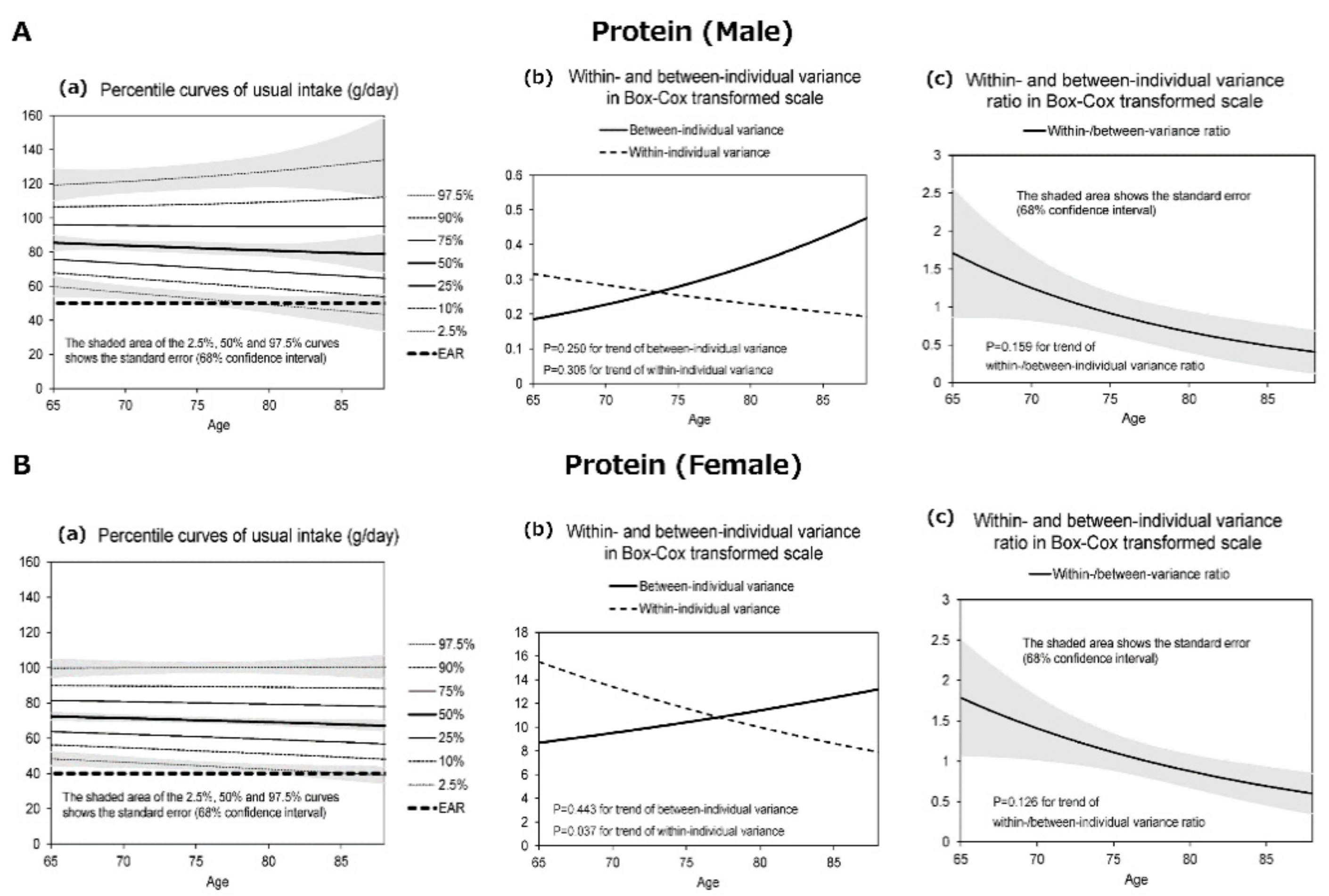
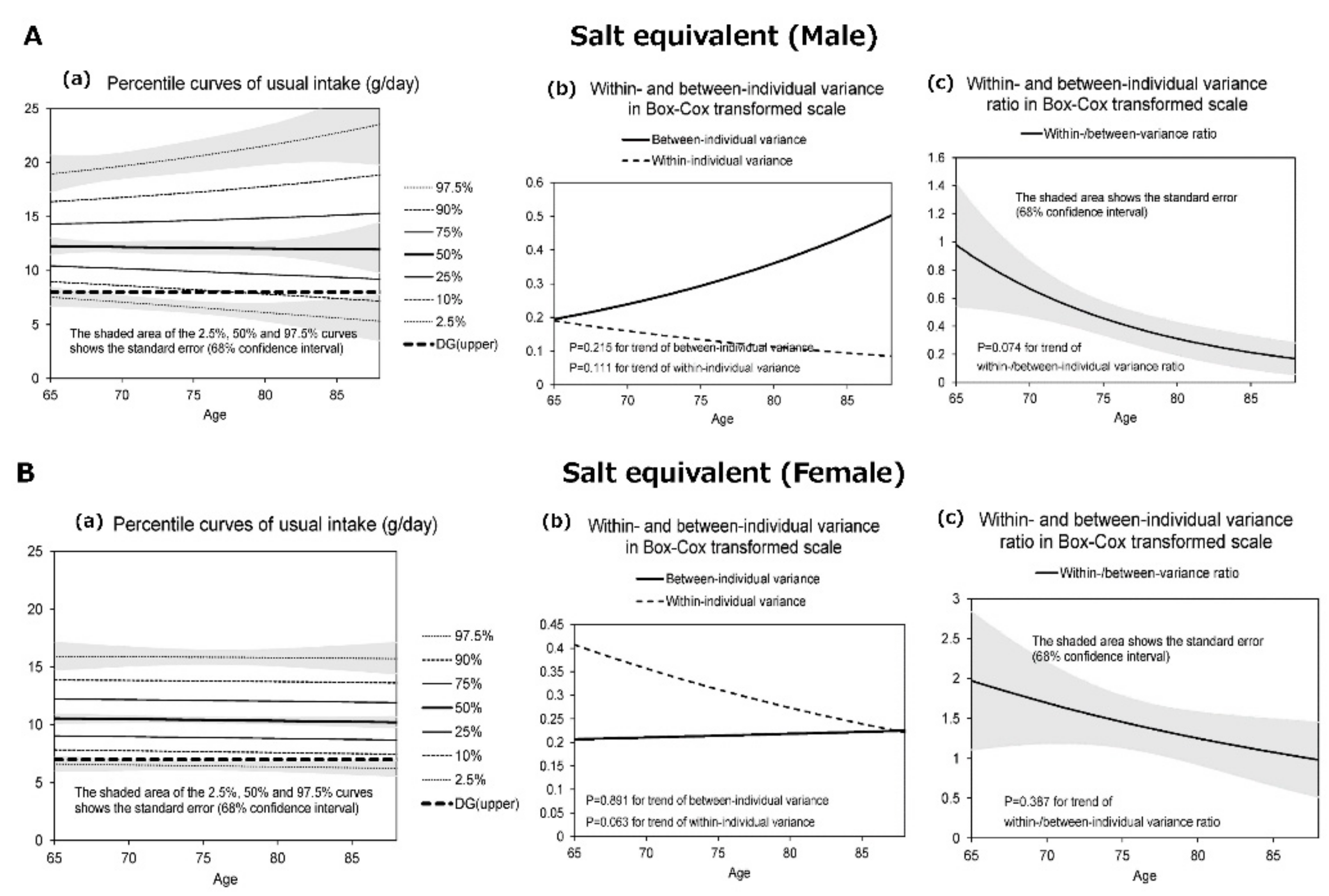
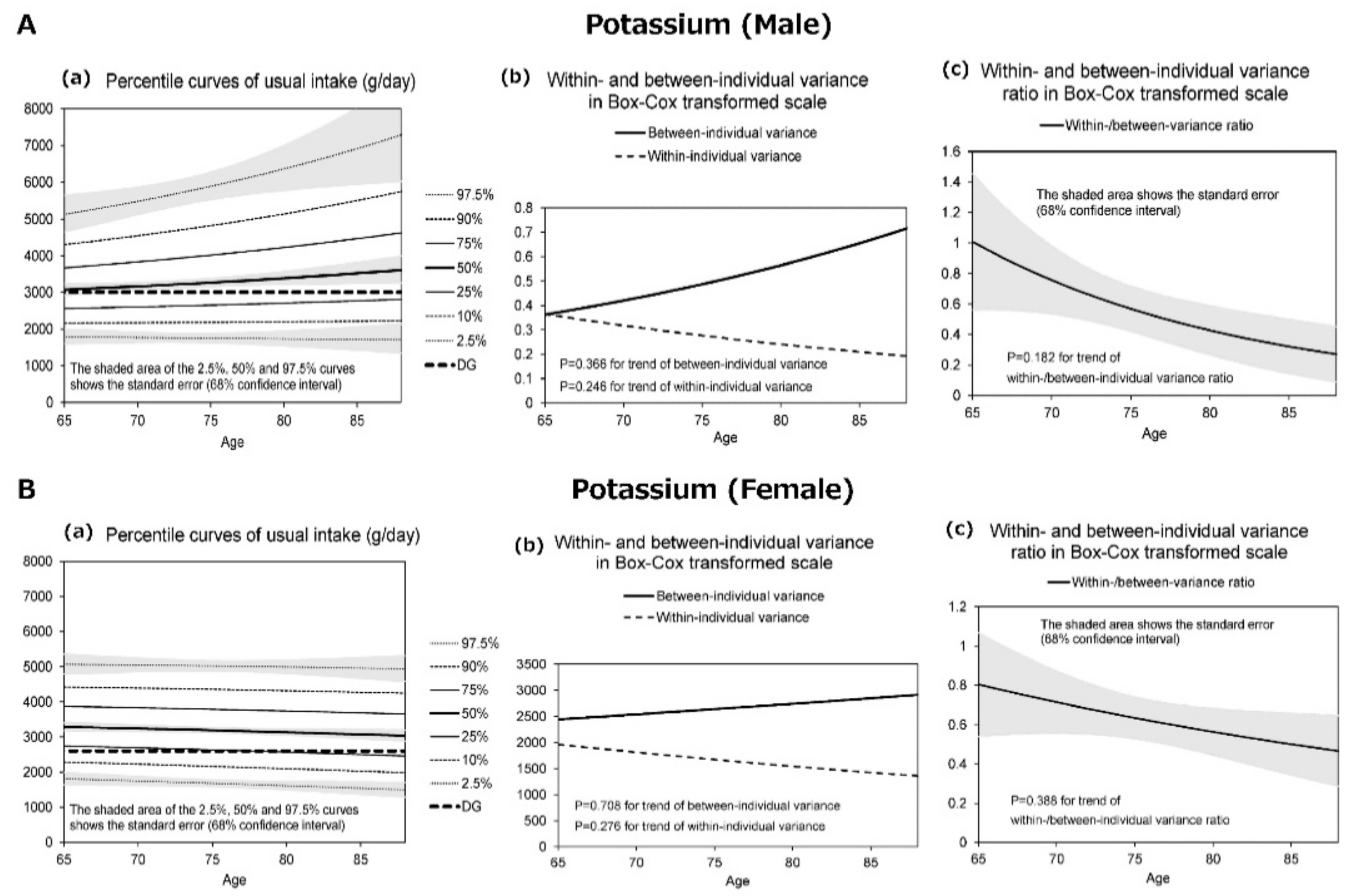
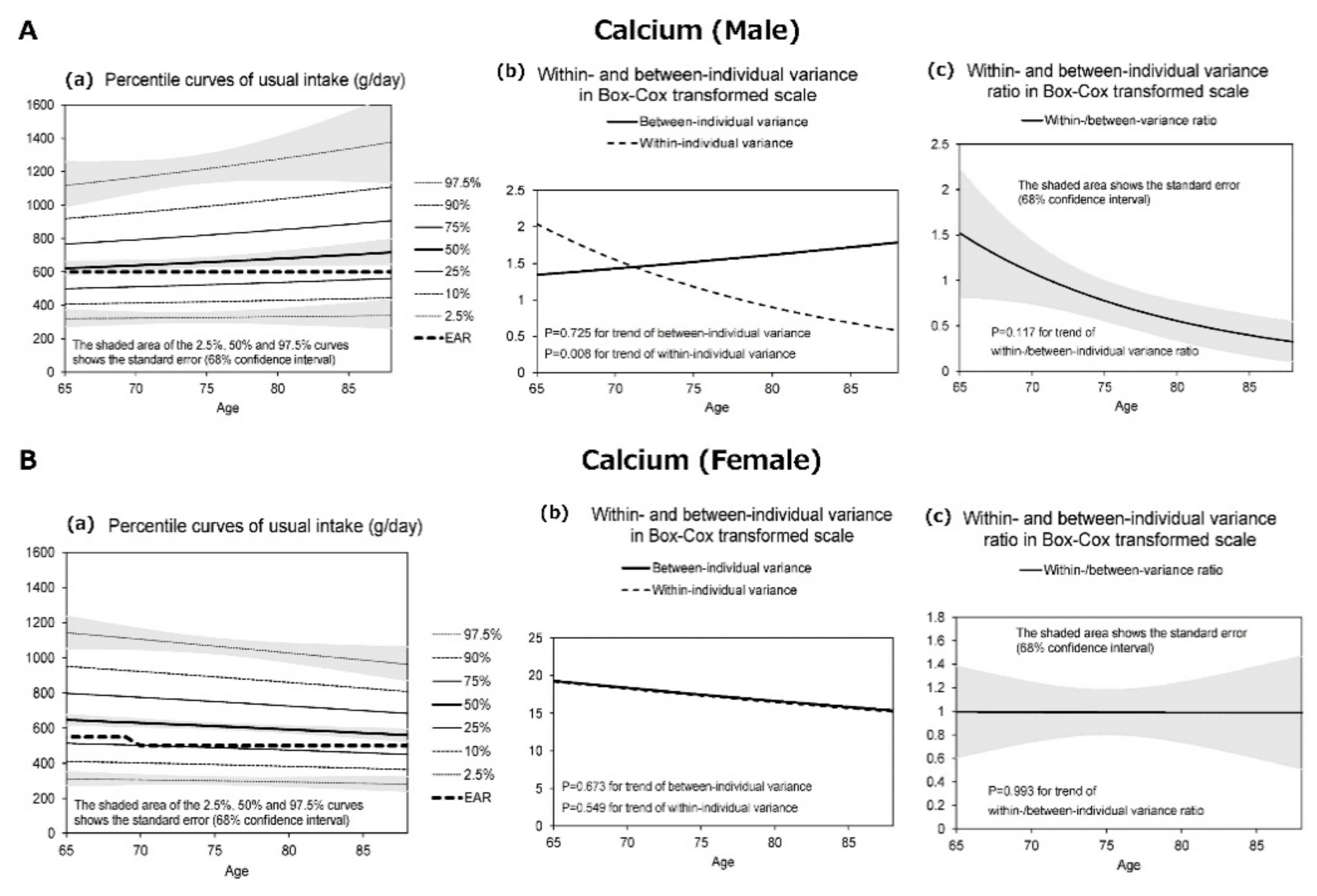
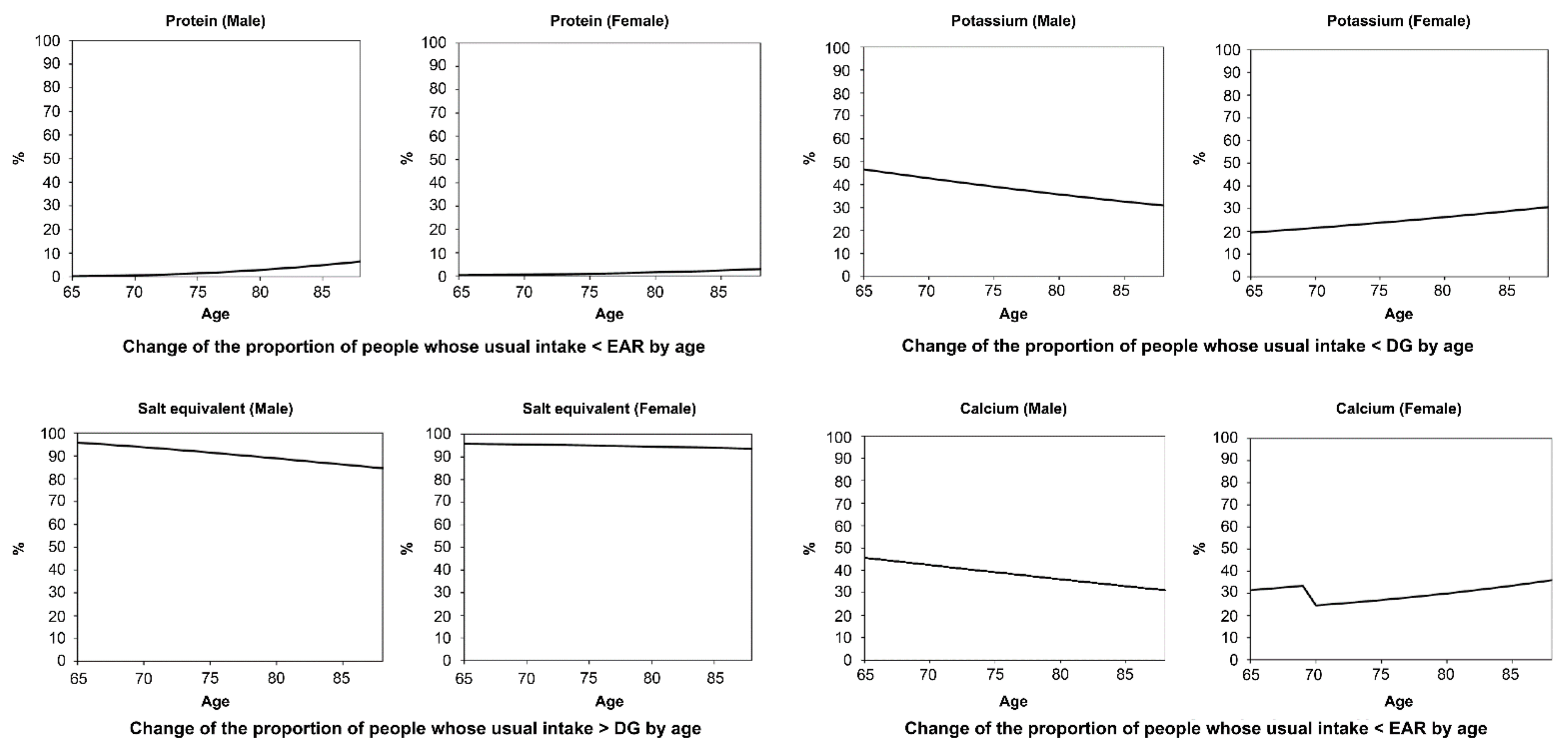
| Age (Years) | |||||||||||
|---|---|---|---|---|---|---|---|---|---|---|---|
| Male | Female | ||||||||||
| 65–74 Years (n = 64) | 75–90 Years (n = 45) | p | 65–74 Years (n = 128) | 75–90 Years (n = 124) | p | ||||||
| n | % | n | % | n | % | n | % | ||||
| Annual income (JPY) 1,2 | ≥4 million (≥$36,364) | 4 | 3.1 | 4 | 4.4 | 0.007 | 4 | 1.6 | 6 | 2.4 | <0.0001 |
| 2–4 million ($18,182–36,363) | 46 | 35.9 | 48 | 53.3 | 62 | 24.2 | 54 | 21.8 | |||
| 1.5–2 million ($13,636–18,181) | 36 | 28.1 | 10 | 11.1 | 64 | 25.0 | 26 | 10.5 | |||
| 1–1.5 million ($9090–13,635) | 16 | 12.5 | 18 | 20.0 | 66 | 25.8 | 52 | 21.0 | |||
| <1 million (<9090) | 10 | 7.8 | 4 | 4.4 | 38 | 14.8 | 78 | 31.5 | |||
| do not want to answer | 16 | 12.5 | 6 | 6.7 | 22 | 8.6 | 32 | 12.9 | |||
| Highest level of education attained 2 | University graduate school | 30 | 23.4 | 28 | 31.1 | 0.001 | 8 | 3.2 | 4 | 1.6 | 0.004 |
| College, special school | 16 | 12.5 | 2 | 2.2 | 38 | 15.0 | 24 | 9.7 | |||
| High school | 62 | 48.4 | 30 | 33.3 | 108 | 45.5 | 82 | 33.1 | |||
| Primary, secondary school | 18 | 14.1 | 26 | 28.9 | 90 | 35.4 | 130 | 52.4 | |||
| Do not want to answer | 2 | 1.6 | 4 | 4.4 | 10 | 3.9 | 8 | 3.2 | |||
| Nutritional status 3 | Height (mean; SD) | 164.0 | 7.6 | 161.8 | 5.5 | 0.015 | 150.4 | 5.3 | 147.9 | 5.6 | <0.0001 |
| (minimum–maximum) | 133 | 178 | 148 | 169 | 135 | 164 | 130 | 158 | |||
| Weight (mean; SD) | 63.9 | 10.2 | 59.8 | 8.6 | 0.007 | 52.9 | 8.1 | 49.2 | 7.1 | <0.0001 | |
| (minimum–maximum) | 45 | 93 | 40 | 78 | 31 | 76 | 32 | 73 | |||
| BMI (mean; SD) | 23.7 | 2.9 | 22.9 | 3.1 | 0.064 | 23.4 | 3.3 | 22.5 | 3.1 | 0.001 | |
| (minimum–maximum) | 16.9 | 32.3 | 16.4 | 29.5 | 15.4 | 32.9 | 15.6 | 32.8 | |||
| Special nursing needs 2 | No | 126 | 98.4 | 84 | 93.3 | 0.048 | 254 | 99.22 | 220 | 88.71 | <0.0001 |
| Yes | 2 | 1.6 | 6 | 6.7 | 2 | 0.78 | 28 | 11.29 | |||
| Frailty index (Kaigo–Yobo checklist) 2 (0–15 points) | ≥4 points | 22 | 17.2 | 24 | 26.7 | 0.091 | 30 | 11.7 | 78 | 31.5 | <0.0001 |
| <4 points | 106 | 82.8 | 66 | 73.3 | 226 | 88.3 | 170 | 68.6 | |||
Publisher’s Note: MDPI stays neutral with regard to jurisdictional claims in published maps and institutional affiliations. |
© 2021 by the authors. Licensee MDPI, Basel, Switzerland. This article is an open access article distributed under the terms and conditions of the Creative Commons Attribution (CC BY) license (https://creativecommons.org/licenses/by/4.0/).
Share and Cite
Ishikawa, M.; Yokomichi, H.; Yokoyama, T. Difference and Variance in Nutrient Intake by Age for Older Adults Living Alone in Japan: Comparison of Dietary Reference Intakes for the Japanese Population. Nutrients 2021, 13, 1431. https://doi.org/10.3390/nu13051431
Ishikawa M, Yokomichi H, Yokoyama T. Difference and Variance in Nutrient Intake by Age for Older Adults Living Alone in Japan: Comparison of Dietary Reference Intakes for the Japanese Population. Nutrients. 2021; 13(5):1431. https://doi.org/10.3390/nu13051431
Chicago/Turabian StyleIshikawa, Midori, Hiroshi Yokomichi, and Tetsuji Yokoyama. 2021. "Difference and Variance in Nutrient Intake by Age for Older Adults Living Alone in Japan: Comparison of Dietary Reference Intakes for the Japanese Population" Nutrients 13, no. 5: 1431. https://doi.org/10.3390/nu13051431
APA StyleIshikawa, M., Yokomichi, H., & Yokoyama, T. (2021). Difference and Variance in Nutrient Intake by Age for Older Adults Living Alone in Japan: Comparison of Dietary Reference Intakes for the Japanese Population. Nutrients, 13(5), 1431. https://doi.org/10.3390/nu13051431






